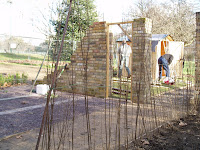Follow the volunteers' progress as they cultivate a wildlife-friendly garden in heart of London's Regent's Park
29/01/2007
Snow in the garden!
Another week for the wildlife garden and all seems to be holding up well, despite the garden experiencing its first snow. The turf is looking a bit bumpy but unfortunately it was really too wet when it was laid. However like the hedge, you need to get turf down quite quickly once it has been dug up so the roots don't dry out. Later when the ground is dryer in the spring, we will lift the uneven areas of turf and put some soil underneath to flatten it out.
22/01/2007
Planting hedges

Volunteers planting the privet hedge would have found it easier if the ground wasn't quite so wet! However the hedge plants we ordered were bare-rooted which meant they needed to be planted straight away. Fortunately the soil wasn't too saturated so the roots won't drown. The plants should settle in well this spring.
Privets aren't the best of hedges for wildlife. Our other hedge consists of hawthorn and holly which are both excellent for attracting wildlife but as privet is such a common hedge plant we thought we would plant one just to show how it can be improved for wildlife. We will be planting species such as honeysuckle in the hedge which will make it more interesting to look at as well as provide more homes and food for wildlife.
17/01/2007
Exciting week for the wildlife garden

Not only were 2 hedges planted, the turf laid and some plants put into the front garden, but the shed also arrived. The shed roof is topped with sedums and creates a wildlife habitat even when the ground below has been concreted over. The only care you have to give the sedums is an initial soaking and then an occasional watering if there is a really dry period.
The planting was carried out by volunteers and some young people from Rise Phoenix. One hedge planted was a hawthorn and holly mix, both of which provide berries for birds and are also good species for invertebrates to live in. The other is a privet hedge - this isn't so wildlife-friendly but we are going to improve it for wildlife by growing climbers such as honeysuckle through it. The front garden was planted with low growing plants that can survive in shade and also under a car.
05/01/2007
Garden activities in January

We are looking forward to a month of activity in the wildlife garden. We will be planting some more hedge and laying some turf in the wildlife garden area. A small area of this grass will be allowed to grow long. This is really important for lots of insects including several species of butterfly which lay their eggs in long grass and their caterpillars feed on it too. The patch of long grass needn't be large nor take up too much valuable lawn area in order to provide some important space for wildlife.
Also in January, we are looking forward to the installation of our green-roofed shed. For people who don't have much space to garden, roofs are another place to think about using for this purpose. There are many ways of doing this and a whole wealth of information is on the web about how you might go about it.
Subscribe to:
Comments (Atom)
